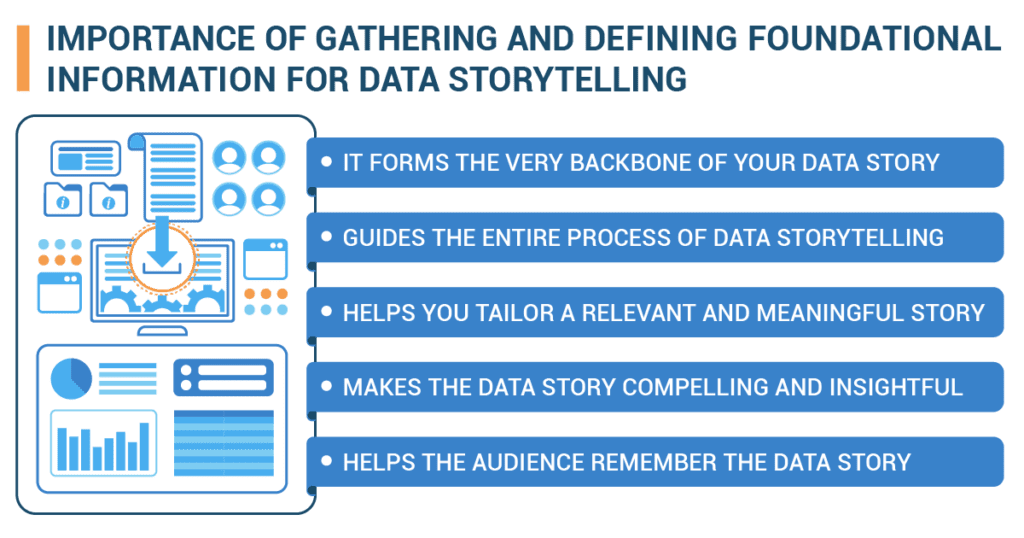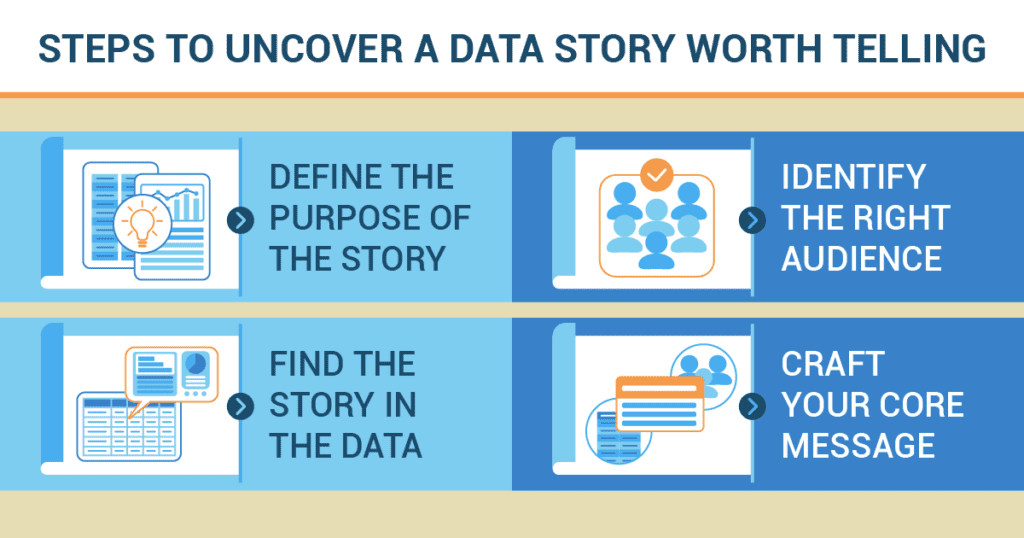Picture this: You wake up, look at your phone, and you see a notification that your daily screen time has shot up by 40%. You’d feel concerned, wouldn’t you? But then you remember: yesterday, you spent hours on a video call catching up with old friends. Suddenly, that 40% increase isn’t an alarming reflection of digital addiction but a cherished memory of connection and laughter.
This, folks, is the power of context.
Imagine, for a moment, your life as a dataset. Every interaction, every step, every heartbeat—an endless series of data points. Now, taken individually, these data points may seem trivial, mundane, or even bewildering. But once you stitch them together, add some context, and examine the patterns, a unique narrative unfolds. Your narrative. The story of you.
Gathering and Defining Foundational Information

So, why do we need to gather and define foundational information for data storytelling? Well, imagine trying to solve a case without knowing what crime was committed, who might have seen it, or what evidence to look for. You’d be lost!
The same goes for data storytelling. We need a clear purpose, like why we’re investigating this data. Is it to understand why the office cafeteria is always out of pizza on Wednesdays? Or maybe we want to figure out if taller athletes are better at basketball? The purpose guides everything we do next. It shapes the direction of the data analysis, determines the type of insights that are relevant, and influences the design of the narrative.
Then, we need to know our audience or who we’re telling the story to. Are we explaining the pizza problem to the lunch lady, or the basketball situation to the coach? Depending on who we’re talking to, we’ll need to adjust our language and how much detail we give.
And, of course, we need our findings – the actual data. These are the facts, figures, trends, and patterns we find in the data that will help us tell our story. It’s like the detective finding a footprint at the crime scene – a crucial clue!
Uncover a Data Story Worth Telling

- Define the purpose of the story: We want to figure out why the cafeteria keeps running out of pizza on Wednesdays.
- Identify the right audience: Our audience is the lunch lady and the company management because they have the power to fix the problem.
- Find the story in the data: We start gathering data – maybe we survey employees about their favorite lunch meals, or we check the cafeteria records. We find out that on Wednesdays, there are more employees staying for lunch because of meetings, and pizza is their favorite meal.
- Craft your core message: Based on our findings, our core message (key takeaway) is, “The cafeteria needs to make more pizza on Wednesdays because more employees eat lunch at the office that day due to meetings.”
Unveiling Lego’s Success: Contextual Data Storytelling
In the world of innovation and creativity, “BrickCraft” emerged as a pioneering company known for its iconic Lego sets that ignited imaginations across generations. The company’s Chief Marketing Officer, Alex Reynolds, found himself at the intersection of numbers and narratives – a realm where data storytelling held the key to uncovering the essence of Lego’s success. Alex recognized that beyond the bricks and blocks, the story of Lego’s journey was interwoven with contextual data that needed to be revealed.
Alex was a visionary marketer with a deep appreciation for the power of narratives. The challenge he faced was to showcase Lego’s enduring popularity and why it resonated so strongly with people of all ages. He understood that numbers alone wouldn’t suffice – context was the canvas upon which the story of Lego’s triumph would unfold. BrickCraft’s legacy spanned decades, and its brick-based play concept seemed timeless. Alex aimed to understand what made Lego special beyond its tactile appeal. This challenge was not just about data but about unearthing the intangible elements that turned Lego into a cultural icon.
In a brainstorming session with his marketing team, Alex underscored the importance of context in data storytelling. He likened data to a puzzle, and context as the frame that gave the puzzle meaning. Without context, numbers remained disparate pieces; with context, they transformed into a coherent narrative. The journey began by delving into Lego’s historical archives, customer surveys, and sales data. These numbers represented the bricks of the story, waiting to be assembled in the right order.
Alex’s team sought to uncover the “why” behind Lego’s popularity. They explored customer feedback, discovering that Lego’s universal appeal stemmed from its open-ended creativity. Lego sets could be transformed into anything a person’s imagination desired. Contextual data showed that Lego wasn’t just about play – it fostered bonding between generations. The team uncovered stories of parents and grandparents sharing their love for Lego with their children and grandchildren, creating a legacy of creativity.
Armed with contextual insights, Alex’s team wove a narrative that showcased Lego’s evolution as a vessel for imagination, creativity, and family connections. The numbers took on life, supported by the context that breathed significance into every data point. The result was a captivating data-driven story that went beyond metrics. Alex’s team shared this narrative through marketing campaigns, social media, and events, highlighting Lego’s resonance across ages and cultures. As the narrative spread, BrickCraft observed heightened customer engagement and renewed interest. Lego’s legacy resonated with people on a deeper level, fostering a stronger emotional connection with the brand.
Conclusion:
In the world of marketing and innovation, BrickCraft showcased the transformative power of contextual data storytelling. Alex Reynolds’ understanding of context allowed him to unravel Lego’s story, transcending numbers and embracing emotions. By harmonizing data with context, corporate professionals like Alex breathed life into analytics, creating narratives that not only informed but also inspired, and solidified Lego’s position as an enduring beacon of creativity and connection in the hearts of people worldwide.